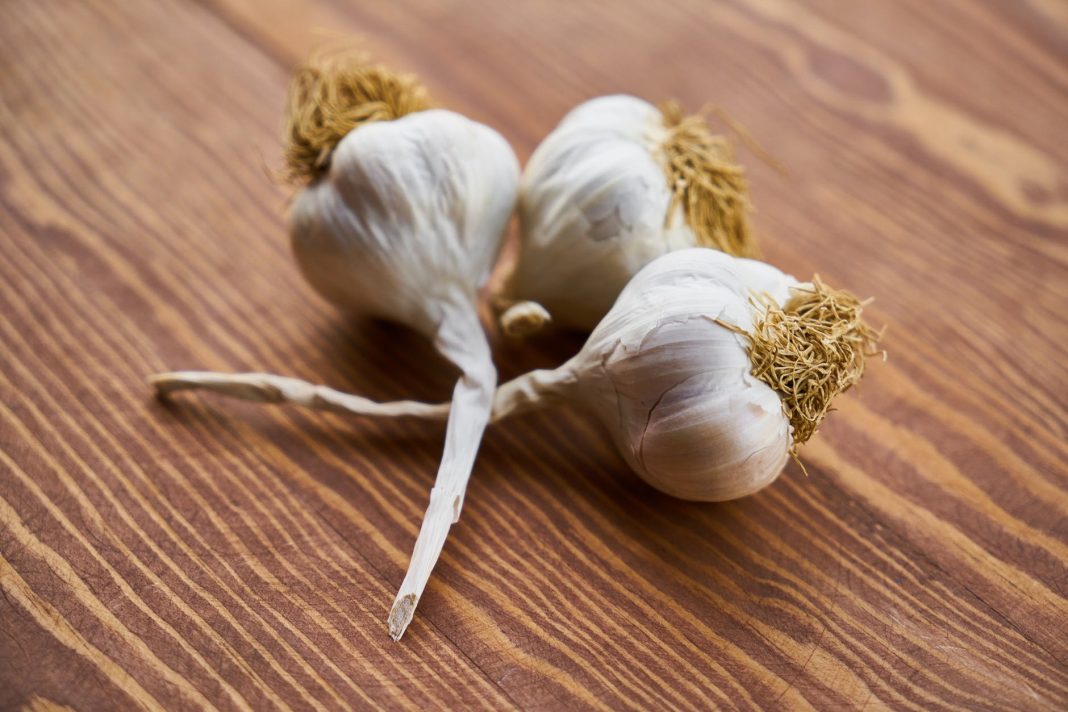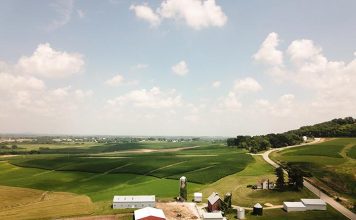 |
|
| Issue #98 • March/April, 2006 |
Garlic is one of our oldest herbs on record. Anyone can grow garlic without having to hover over it, hoping that it produces. That’s far more than I can say about some other seasoning plants I have tried. Gardeners who can’t raise garlic can’t raise dust. There are many varieties of garlic and some grow better in a cool climate than a warm one, but you can bet there’s one or more suited for every area. In addition to cultivated garlic, Nature has provided us with a number of wild varieties free for the gathering. There’s no excuse for being unfamiliar with garlic.
Not all herbs are as universally well known as garlic. It is often mentioned in old writings, and its usage has widened over the centuries thanks to people who carried the herb from one place to another as they roamed Planet Earth. However, from way back, folks have had mixed feelings about garlic. Some have hated it with a purple passion, whereas others have declared it a cure-all. Ancient Egyptians regarded it highlya present from the godsand Egyptian slaves refused to work if their portions of garlic were withheld.
No one is sure where garlic originated. The Chinese have benefited from it for centuries, and the Babylonians were using garlic as far back as 3,000 B.C. No matter where it came from, ancient folks recognized garlic as an important health ally and a tasty addition to their food.
Due to garlic being easy to grow and widely distributed, it is generally known as the common man’s herb. It has great value for seasoning meats, soups, cooked vegetables, salads, and so on. Eaten raw, even though its onion-like flavor is delicious, garlic is a turn off in polite society. Sadly, a raw garlic breath will not depart overnight. It takes all of two days to fade away, and that’s not guaranteed. Ironically, the offending person may take comfort in the fact that garlic is loaded with health benefits.
In contrast to its obnoxious side, garlic has a valuable side. it carries a goodly amount of B and C vitamins, protein, phosphorus, and smaller amounts of other health boosters such as calcium, iron, and potassium. Garlic has long been recognized for its medicinal values, among which is the lowering of high blood pressure.
|
For those who take folk remedies seriously, garlic is well known as a remedy for sore throats, colds, coughs, and related illnesses. A soothing syrup is made by pouring a quart of boiling water over a pound of cleaned, sliced garlic cloves and allowing mixture to stand covered overnight. (Use stainless steel, porcelain or glassno aluminum.) It is then strained through fine gauze or a fine stainless wire strainer to remove cloves or pieces thereof. Enough sugar, honey, or both are added to the strained liquid to make a thin syrup. This can be administered by tablespoonful as needed.
To add further to garlic’s acclaimed benefits, history records that during the 17th century, when England was caught up in the Great Plague, many people who used garlic were the only ones who could minister to plague victims without contracting the disease themselves. Coming a little closer to modern times, it is said Russia once relied so heavily on the use of garlic for its soldiers that garlic became known as Russian penicillin.
There are now odorless capsules on the market for those who prefer a simple way to ingest garlic. To bolster one’s confidence about no aftereffects, however, I’d ask the pharmacist for the best thing to use “just in case.” Chewing fresh mint, parsley, or orange peelings is often recommended after eating salads or something that contains raw garlic.
Garlic is a perennial that, in the South, comes up in the fall from cloves left in the ground when the crop was harvested. The plant produces green strap-like leaves that remain green all winter. Extreme cold will cause mature leaves to toughen, but there always seems to be a supply of fresh tender leaves coming on to use as seasoning in case one’s supply of cloves runs low. Try cooking a few chopped leaves in with potato soup. This not only has eye appeal but it enhances the flavor of the soup.
Early spring is the best overall time to plant garlic, and if there are odd spots in the garden that aren’t needed to grow something else, try utilizing them to grow garlic. Such places may be next to fences or in corners. Like many other plants, garlic needs sunlight, good soil, and reasonable drainage. A dressing of well rotted compost will help, too. In other words, garlic isn’t fussy about its location as long as a few simple rules are followed.
I plant garlic cloves about 2 inches deep and 6 to 7 inches apart in well-worked soil that is free of weeds. We have raised beds 4×8 feet in size, and about a half bed of garlic produces plenty of cloves for our own use. Plants will start their life cycle in early spring and, as summer approaches, will put up tall flower stalks. Foliage will die down in hot weather, and cloves are ready to be dug when plants are completely dormant. Don’t wait to harvest until fall showers begin as new growth is likely to occur.
A garden fork is best for digging garlic bulbs. Spades have a tendency to slice into the bulbs, damaging some of them. Letting the newly dug cloves lie in a cool shady place for 2 to 3 days will let the clinging dirt dry out, and it will be easier to brush away than fresh dirt.
We prefer to raise Elephant Garlic. It is a type of garlic that produces an exceptional crop in our Zone 8 area (southwestern Arkansas). Elephant has large bulbs and cloves and is mild tasting. We like to clean the dirt from a quantity of the cloves, put them in mesh bags, and hang them near the kitchen where they are easily accessible. They will keep for months in any dry, cool room.
Another way of keeping garlic for culinary use is to dehydrate it. I like this method of preserving garlic as a lot of garlic can be easily stored in jars in a small amount of space. Simply clean fresh cloves thoroughly and remove thin skins, root ends, and any blemishes. Slice cloves into thin slices, place on mesh drying racks, and process in an electric dehydrator at 100° to 120° F. Time required to dry garlic slices may vary according to humidity, altitude, etc. In our area, garlic slices require several hours or overnight to dry. Pieces will be crisp and break easily when ready to remove from the dehydrator. Let them cool off and immediately put them in clean, dry jars. Store in a convenient place such as a kitchen pantry.
|
Dried garlic does not have to be reconstituted before use. Crumble the desired amount of garlic into your casserole, stew, etc., and let it cook with the rest of the ingredients.
If you have a tried-and-true method of dehydrating, by all means stick with it. However, if you are not experienced in drying produce from your garden, I’d highly recommend buying an electric dehydrator. This method of drying cuts out a lot of guesswork and, if taken care of, an electric dehydrator will give years of service. Be sure it has a thermostat so that you do not have to be constantly checking on whatever you are drying. A good dehydrator must have a fan to aid in ventilation. Those without fans may have hot spots in them, which can lead to unevenly dried food.
Timers are okay, but they’re not necessary, as you’re going to check on your items from time to time anyhow, and drying times will vary.
Check out several models of dehydrators and select one that meets your needs. Let common sense be your guide as to overall size needed and cost. Frankly, I’d recommend placing a dehydrator somewhere other than the kitchen when in use. Some items, such as garlic, being dried can produce heavy odors that tend to invade the entire house. Also, there’s usually some noise attached to using an electric dehydrator.
Garlic’s benefits are not confined to the many delicious dishes coming out of the kitchen. It is also used in organic sprays to control insects in the garden and to discourage deer and other animals from munching on certain shrubs. We cat and dog owners often put some minced garlic in our pets’ wet food to kill intestinal worms.
The many facets of garlic go on and on. If you don’t have garlic growing in your garden, what are you waiting for?
Roasted garlic:
Select large garlic bulbs or clusters of attached garlic cloves. Clean and prepare as many as needed for guests, but at least one per person. Handle clusters of cloves gently to avoid too much separation.
Cut tops off of bulbs or clusters and discard or use for something else. Brush with olive oil. Sprinkle with freshly minced sweet basil leaves, rosemary or herb of your choice. (Dried herbs may be substituted if fresh ones are not available.)
Wrap each bulb or cluster in aluminum foil, and place on a cookie sheet or shallow baking pan. Bake at 350° F, for about 35-40 minutes or until soft.
Serve alongside cooked meats or vegetable dishes.
Crusty garlic bread:
1-pound loaf French bread
½ cup butter or good grade oleo, melted
3-4 small garlic cloves, minced
2 Tbsp. fresh parsley, finely chopped
French bread seems to be the preferred bread for this recipe, although other breads are good, too. Select a crusty type bread rather than a soft, sandwich type bread.
Slice French loaf lengthwise and place both halves cut-side up on a baking sheet. Combine butter and garlic and brush over cut sides of bread. Sprinkle with minced parsley. Bake in 350° F oven about 7-8 minutes and then move bread to broil 4-6 inches beneath heat until golden brown, usually about 2 minutes. Keep a close watch so as not to burn.
Cut into 2 inch slices and serve warm.
Guacamole dip:
1 ripe avocado, peeled, mashed, seed discarded
1 Tbsp. onion, minced
½ tsp. chili powder
1 small clove garlic, cleaned and minced
1 Tbsp. fresh lemon juice
1 medium ripe tomato, peeled and chopped in small pieces. (Dip tomato in boiling water just long enough to slip off skin.)
Combine all ingredients and chill in covered container (no aluminum). Serve with corn chips or veggie sticks (carrot, bell pepper, cucumber, etc.)
New potatoes with garlic:
16-18 New potatoes, cleaned and quartered (do not peel)
¼ cup melted margarine
¼ tsp. ground black pepper
1 small bell pepper, chopped
2 medium cloves garlic, peeled and minced
2 Tbsp. fresh parsley, chopped fine
Boil potatoes until tender in just enough water to cover. Saute bell pepper and garlic in margarine until tender crisp and add pepper and parsley. Combine thoroughly with hot potatoes. This is a good side dish to be served with meat.
Companies offering several types of garlic, including Elephant Garlic:
R. H. Shumway’s
334 W. Stroud St.
Randolph, WI 53956-1274
J.W. Jung Seed Co.
335 S. High St.
Randolph, WI 53957-0001
Henry Field’s Seed & Nursery Co.
P.O. Box 397
Aurora, IN 47001-0397
















